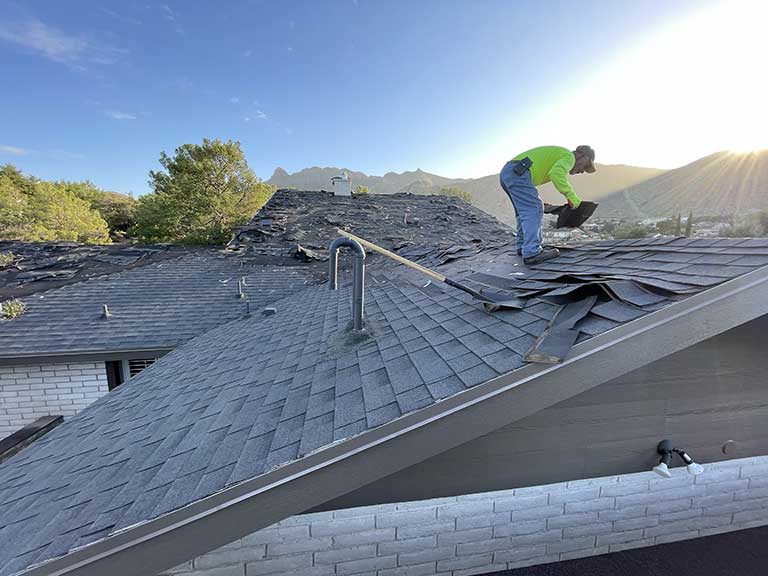Which is the correct way to install a roofing system on a house?
by siteadmin

The Right Way to Install a Roof on a House
The contractor begins by removing old shingles. This step is labor-intensive, but essential to avoid premature roof failure.
The contractor will install wide metal flashing (metal flashing) at the gable walls, chimneys, front walls and chimney ends. He will also nail new drip edge along bottom of roof.
Flashing
Flashing is used wherever there is a roof opening that could allow water to seep through. This includes the corner between a dormer wall and the wall itself, the chimney vent, the kitchen vent or even the skylight.
Some roof features like chimneys require two-part flashing systems. Base flashings are placed beneath the chimney, followed by counter-flashings above. This allows the materials' expansion and contraction due to temperature fluctuations to be accommodated.
It's important to not nail the flashing on both the wall as well as the roof shingle. This could cause it to get a wrinkled-looking look. This is an invitation to leaks. It's important to pick the right flashing material. Copper is a popular choice because its surface doesn't rust, and it goes well with a range of different roofing materials.
Nails
Even the smallest of details can make a difference in the durability and performance of your roofing system. If you drive a nail above the shingle nail zone, also known as "high nails", it will not hold the shingle in place. This can lead to the shingle coming loose or blowing off in windy climates.
The manufacturer of shingles will provide instructions for the placement and driving of nails. Unfortunately, most installers fail to adhere to these instructions. This often leads to incorrectly placed or overdriven nails.
To ensure the best resistance to corrosion, nails should be made from galvanized, stainless steel or copper. Avoid using aluminium nails. They can oxidize the sheathing board and leave it exposed to moisture.
Sealants
Sealants protect roofs from moisture and damage caused by the sun. The type sealant you select depends on the size of your project and the weather conditions of your region.
Silicone sealants have the ability to withstand heavy downpours and provide an effective waterproof barrier. They also reflect sunlight which keeps homes cool and reduces the use of air conditioning, saving you money on electricity.
Acrylic sealants have a moderate moisture resistance, and they are designed to reflect UV rays. These sealants are popular in states like the southwest and western states, where roof damage is a big concern.
The polyurethane sealants have a high resistance to water, but they are not as resistant against UV rays. They're best for sloped rooftops, as standing pools of moisture are less likely. The thicker solvent-based products can be applied easily by brushing and rolling, whereas the thinner liquid-based products are easier to apply with a paintbrush or caulking guns.
Installation
Although savvy DIYers may be able to save money by learning the basics of roofing their own home, it remains a huge job. It takes time and effort to get the job done correctly. It is also crucial to understand the best practices of safety and quality for roofing panels and shingles.
Install ice-dam protection in regions which require it. It is a synthetic waterproof material that prevents melting water from backing under shingles and piercing sheathing. Then, you can apply a layer a asphalt roofing paper to the sheathing.
The contractor then installs the first course. They should follow the tile manufacturers' layout recommendations for nailing and positioning. For example shingle exposures need to be equal, with a head-lap that is at least three inches (unless tile specifies something else). Metal roof panels may be attached with clips or by a screwing flange to allow for thermal expansion.
https://www.t2kroofingtempletx.com/
The Right Way to Install a Roof on a House The contractor begins by removing old shingles. This step is labor-intensive, but essential to avoid premature roof failure. The contractor will install wide metal flashing (metal flashing) at the gable walls, chimneys, front walls and chimney ends. He will also nail new drip edge along…
Recent Posts
- Roofing Fresno California: Professional Contractors
- Roofers North Port FL
- Corpus Christi Roofing Co.
- Roofing Company Savannah Sheds Light on the Lifespan of Roofs: How Long Should a Roof Last?
- New Orleans Concreters Advocates for Stamped Concrete Driveways as the Ultimate Choice for Durability and Style
